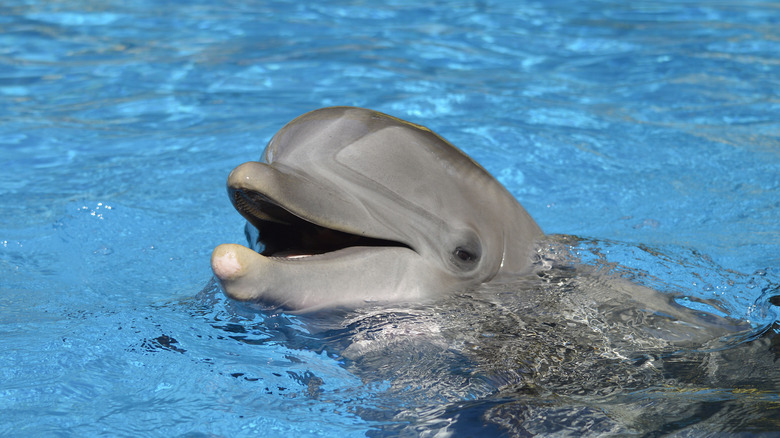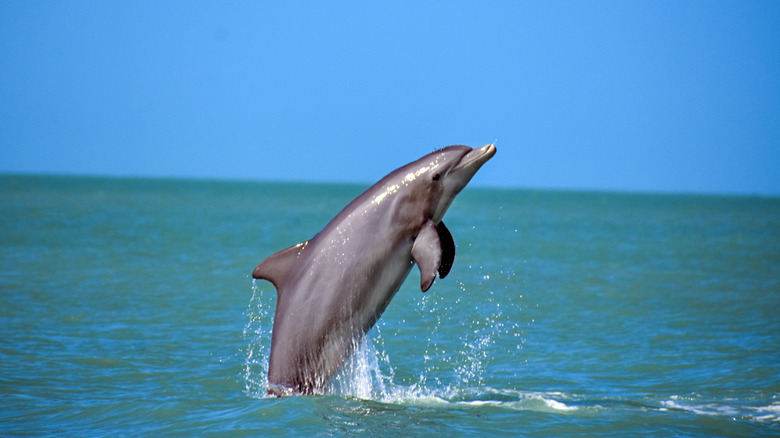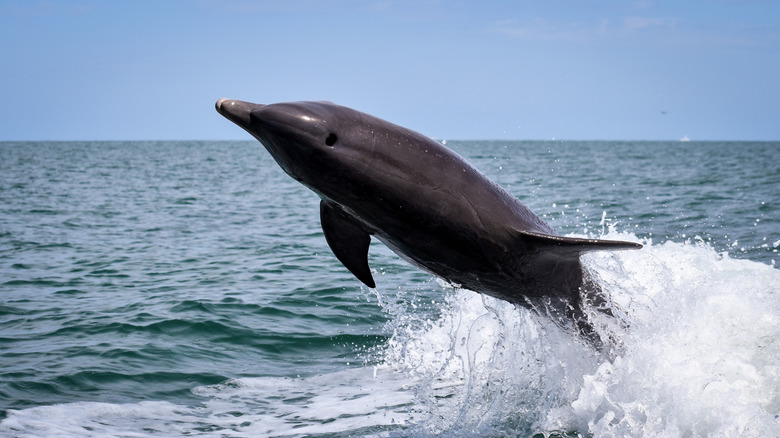The Pristine Florida Beach Where Boat Tours Use One Trick To Attract Dolphins
Florida is one of the most fascinating locations for wildlife in the United States. While the Sunshine State is home to a number of invasive and often dangerous species such as the Burmese python, it also boasts impressive biodiversity. It is, for example, the only place in the U.S. where you can see alligators and crocodiles together and hosts a range of endangered species that can only be found in Florida.
The state's marine wildlife is just as diverse. Florida's oceans are full of multiple shark species such as the bull shark and even the occasional great white. Chances are, however, if you're visiting Florida for the impressive array of marine life, you're probably not hoping to encounter any of these predators, which aren't quite as big a tourist attraction as, say, the dolphins that are even more prevalent in the coastal waters around Florida.
Though the state's surrounding oceans contain multiple dolphin species, the bottle-nosed dolphin is the most common and is a big tourist attraction. In Florida, visitors can view dolphins in aquariums, swim with them, and see them in their natural environment on boat tours. Of course, it would be a tad disappointing if you made the trip out on a boat and didn't see any dolphins at all, which is why boat tours have a specific trick to ensure the marine mammals always come to say hi to tourists.
How boat tours guarantee dolphin sightings in Florida
Over on the west-central coast of Florida on a barrier island in the Gulf of Mexico sits Clearwater Beach. Known for its white sand, the area is a big tourist attraction, not least for hosting many bottle-nosed dolphins. Families of these impressive marine mammals are found year-round in Clearwater Harbor and the surrounding inter-coastal waterway. They're known for being curious and friendly and can be identified by their lighter grey coloration on top and a white underside. The animals can reach anywhere from 6.6 to 13.1 feet long and typically weigh between 330 and 1,400 pounds. Bottlenose dolphins get their name from their stubby beaks, and are known for regularly engaging in playful behavior amongst themselves and with humans.
It's this sociable aspect of their personality that allows boat tours to all but guarantee visitors will catch a glimpse of the creatures. Boat tours of Clearwater Beach's bay guarantee dolphins on every trip because they know the animals can't resist the wake thrown up by their boats. A company called Little Toot in particular has designed its two vessels with this in mind. The Little Toot boat and the Little Toot II were constructed with a tug boat shape in mind and provided with enough power to produce wakes that dolphins find irresistible. As such, the animals can reliably be seen frolicking behind the boats.
What is it about wakes that these dolphins find so alluring? Well, scientists aren't certain one way or another, but it undoubtedly has to do with the animals' love of fun and may also serve a utilitarian purpose for dolphins.
Dolphins and other cetaceans can't resist a good wake
Cetaceans such as dolphins and porpoises are known to enjoy playing in a ship's wake and bow waves. It's one of the main characteristics of dolphins in particular, with the animals demonstrating a real talent for this bow-riding. Dolphins are able to maneuver their bodies in a way that allows them to be propelled by the waves, without the need for much activity on their part at all.
This behavior is likely a dolphin adaptation from surfing on large waves in the past, though the exact reason for bow-riding among dolphins and other cetaceans has been debated for some time. Some experts suggest the animals engage in this behavior to travel from one location to another quicker and easier than they would if they were simply swimming. Others have suggested bow-riding is merely a playful activity.
A 2024 study published in Scientific Reports used an aerial recording system to follow and film dusky dolphins bow-riding in front of a research vessel. The researchers also recorded free-swimming dolphins off Kaikoura in New Zealand and found that the respiration rates of bow-riding dolphins remained mostly constant regardless of their speed. More importantly, these respiration rates were 45% lower than free-swimming dolphins, suggesting that dolphins may bow ride to save energy. That said, dolphins may engage in bow riding for both energy savings and the simple fact it's fun. The Florida example seems to suggest the dolphins are more interested in the recreation of bow-riding than anything else, since the animals clearly enjoy their experience leaping between waves and showing off for their human audience.


